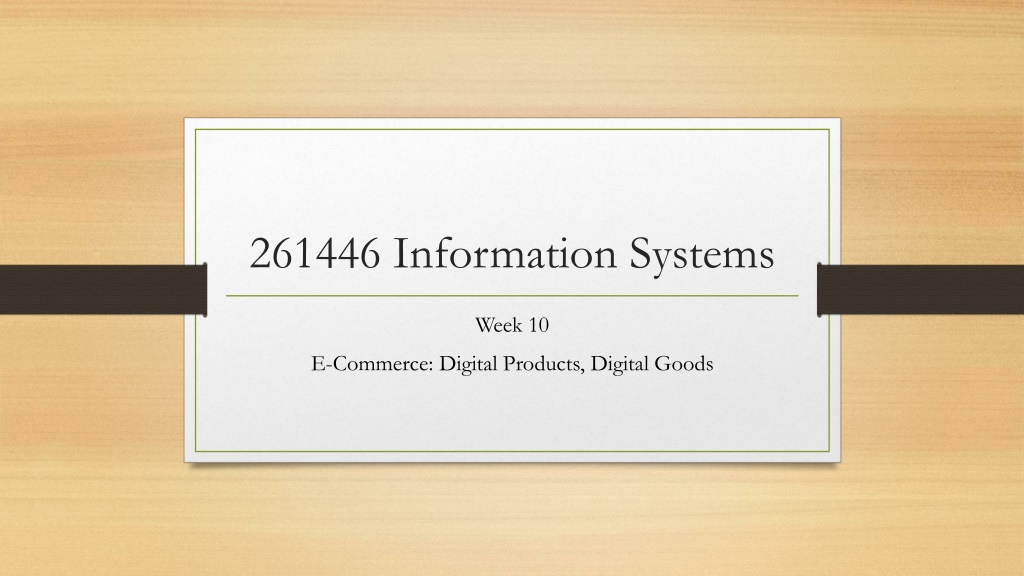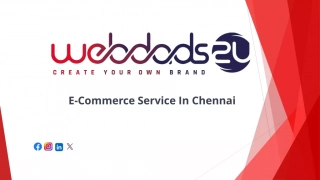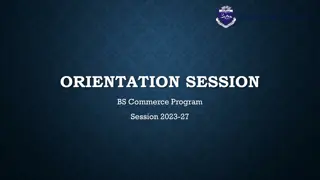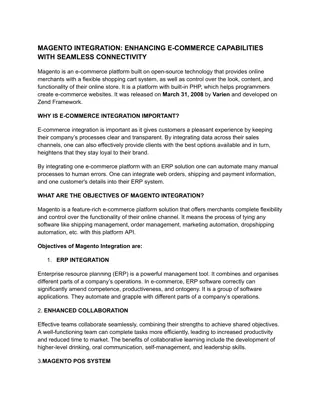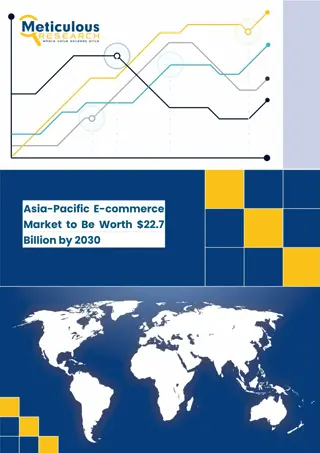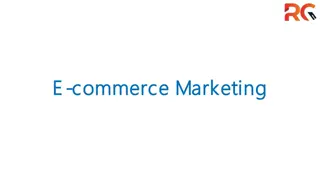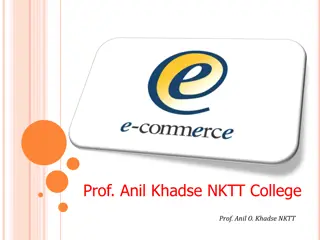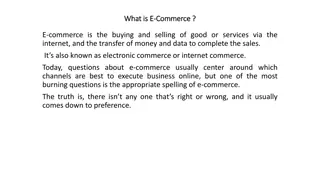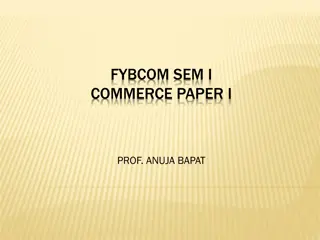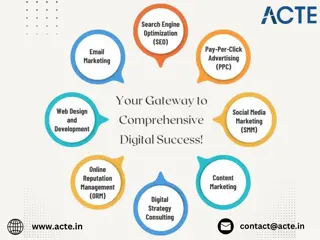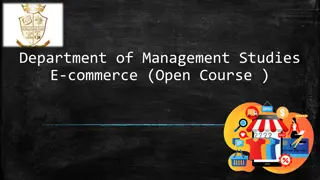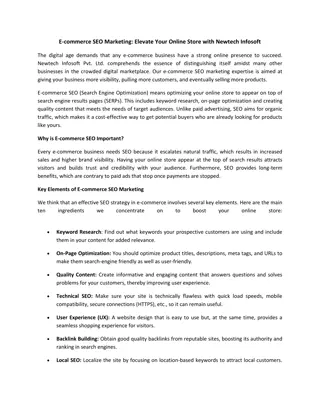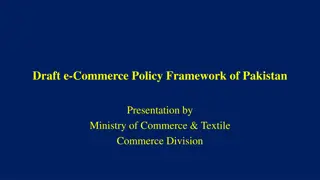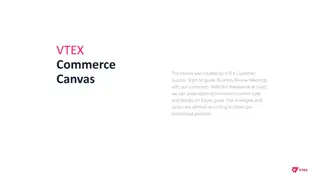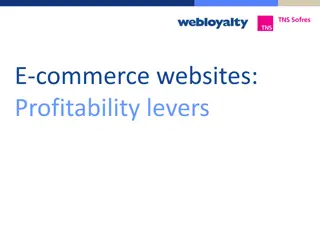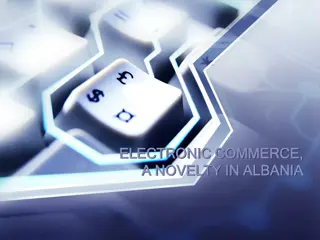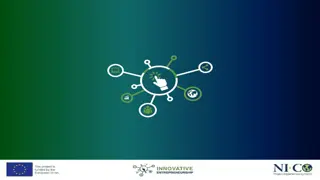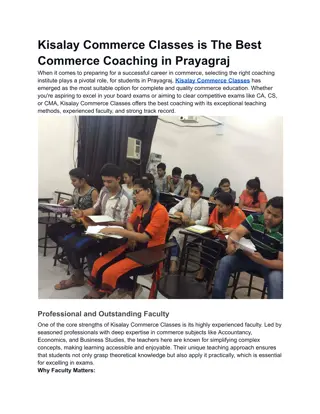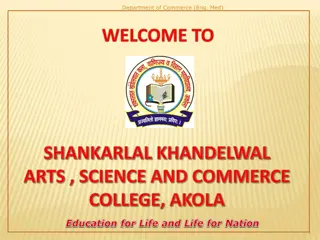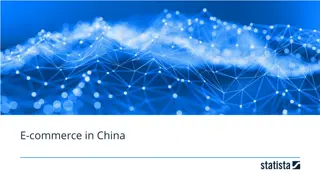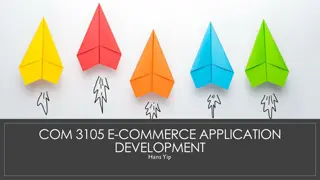Understanding the Impact of E-Commerce on Business and Technology
E-Commerce has seen massive growth since 1995, transforming the way commercial transactions occur between organizations and individuals over the Internet. This form of commerce has become the fastest-growing compared to physical retail stores, services, and entertainment, with social and mobile commerce leading the way. The unique nature of the e-commerce environment offers global reach, universal standards, richness, interactivity, and personalization, making it a crucial aspect of modern business operations.
Download Presentation

Please find below an Image/Link to download the presentation.
The content on the website is provided AS IS for your information and personal use only. It may not be sold, licensed, or shared on other websites without obtaining consent from the author. Download presentation by click this link. If you encounter any issues during the download, it is possible that the publisher has removed the file from their server.
E N D
Presentation Transcript
261446 Information Systems Week 10 E-Commerce: Digital Products, Digital Goods
Week 10 Topics E-Commerce & The Internet E-Commerce: Business & Technology
Case Studies Case Study #1) Youtube Case Study #2) Nasty ending for Nasty Gal
What is E-Commerce? What does the E mean? E-Business? E-Learning? E-Governance? E-Mail? E-
E-Commerce Digitally enabled commercial transactions between and among organisations and individuals Many of which occur over the Internet and the Web Commercial transactions? Exchange of value Money, products, services
E-Commerce Massive growth since 1995 1995 Netscape accepted first ads, creating the idea that the Web would be a new medium for advertising & sales.
E-Commerce Fastest growing form of Commerce (compared to physical retail stores, services & entertainment) Social & Mobile commerce fastest growing forms Wave 1 transformed the books, music & air travel markets; Wave 2 transforms marketing & advertising, telecoms, movies, TV, jewelry, real estate, online travel, bill payments, software. Online demographic has broadened to match ordinary shoppers Small businesses and entrepreneurs are flooding the marketplace, using the infrastructure of E-commerce giants, such as Amazon / Google. Mobile take advantage of location-based services
E-Commerce Wireless / Ubiquitous devices & connections take off Broadband becomes standard Social Networking offer new platform for e-commerce New Internet models of computing emerge Apps, Cloud computing, SaaS, Web 2.0
Why is E-Commerce Different? Unique Nature of environment Ubiquity Global Reach Universal Standards Richness Interactivity Information Density Personalisation / Customisation Social Technology
Ubiquity Technology available everywhere Home, Work, using desktop and mobile devices. The marketplace is extended beyond traditional boundaries, removed from temporal or geographic location. Marketplace is anytime, anywhere Customer convenience is enhanced, shopping costs reduced.
Global Reach Technology breaches national boundaries Across cultural and national boundaries, seamlessly and without modification Potentially billions of consumers and millions of businesses
Universal Standards One set of technology standards IP Disparate computer systems can easily communicate with each other
Richness Video, audio, text messages New media is easily integrated into a single marketing message & consumer experience
Interactivity Technology works by interacting with the user Customers are engaged in a dialog, dynamically adjusting experiences to the individual. The consumer is a co-participant in the process
Information Density Information costs are reduced, while quality raised Information processing, storage and communication costs have dramatically dropped. Currency, accuracy and timeliness improve. Information is plentiful, cheap and more accurate
Personalisation / Customisation Personalised messages can be delivered to individuals and groups Advertising messages based on an individual s characteristics
Social Technology Content Generation and Social Networking User generated content, alongside distribution.
E-Commerce The Internet reduces Information Asymmetry Where one party in a transaction has more information, relevant to the transaction, than another party. This information influences relative bargaining power How much do you know about how much products really cost?
E-Commerce Digital Markets afford Dynamic Pricing The price of a product can vary depending on demand characteristics, or the supply situation Online retailers like Amazon can change prices based on time of the day, demand for the product, supply, the user s prior visits to the site.
Disintermediation Digital Markets afford suppliers to directly connect with their end-users. This may eliminate an intermediary
Digital Goods? Marginal Costs of producing another unit is about zero It costs nothing to copy a music file Cost of producing 1stunit is relatively high nearly the total cost of the product, as inventory & distribution is negligible Cost of delivery very low What is the effect?
Types of E-Commerce B2C Business to Consumer Retailing products to individual shoppers B2B Business to Business Sales of goods & services among businesses C2C Consumer to Consumer Enabling consumers to sell goods to other consumers
E-Commerce Business Models There are various business models operating in E-Commerce Portals E-tailers Content Providers Transaction Brokers Market Creators Service Providers Community Providers
Portals Gateways to the web Gain income through attracting large audiences, advertising, referral fees Include Horizontal, Vertical & Affinity Portals
E-tailer Online Retail Stores From Amazon to small enterprises Some are Bricks & Clicks Retailers Others are pure virtual organisations
Content Providers Providers, not necessarily the creators, of content. Content Any kind of Intellectual Property Text, video, music, photos, artwork
Transaction Brokers Online transaction brokers take commissions for facilitating online transactions Such as in the travel or financial services markets Fees are often less than the traditional versions
Market Creators Provide a platform, or digital environment, upon which buyers and sellers can meet, interact, display products, search for products, establish prices. E-Bay, Amazon, Priceline
Service Providers Hosting service providers For websites, or for photos on social media for example SaaS
Community Providers Platforms that create digital online environments where people can transact; share interests, phots, videos; communicate; receive information; play out fantasies Essentially social networking sites
E-Commerce Revenue Models So, how does the firm earn revenues, generate profits and produce returns on investments? Advertising Revenue Model Eyeballs! Sales Revenue Model Subscription Revenue Model Freemium Revenue Model Transaction Fee Revenue Model Affiliate Revenue Model
